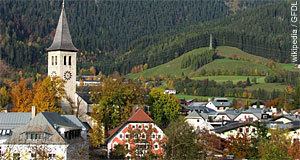Postal code 5760 Elevation 748 m | Time zone CET (UTC+1) Area code 06582 Population 15,884 (1 Apr 2009) | |
 | ||
Weather 12°C, Wind E at 8 km/h, 39% Humidity Points of interest Sommerodelbahn Saalfeden, Schloss Ritzen, Saalfelden Sommerrodeln (sommerrodelbahn), Alpdays Erlebnisgutscheine KG, Schloss Lichtenberg | ||
Saalfelden am steinernen meer 2013 flug mit meinem dji phantom
Saalfelden am Steinernen Meer is a town in the district of Zell am See in the Austrian state of Salzburg. With approximately 16,000 inhabitants, Saalfelden is the district's largest town and the third of the federal state after Salzburg and Hallein.
Contents
- Saalfelden am steinernen meer 2013 flug mit meinem dji phantom
- Map of 5760 Saalfelden Austria
- Gruppe b rallyelegenden saalfelden am steinernen meer
- Geography
- Saalfelden Basin
- Subdivisions
- History
- Sport and leisure
- In Saalfelden born
- References
Map of 5760 Saalfelden, Austria
Gruppe b rallyelegenden saalfelden am steinernen meer
Geography
Although the Saalfelden area has always been the most populous of the historic Pinzgau region, the seat of the district administration is situated in the neighbouring town of Zell am See.
Saalfelden Basin
Saalfelden am Steinernen Meer lies at 744 m (2,441 ft) above sea level and its municipal area covers 118 km2 (46 sq mi). The largest proportion of the municipality is formed by the Saalfelden Basin (Saalfeldner Becken) situated between the Northern Limestone Alps ranges of:
To the south the basin is generally open, running into the Zell Basin (Zeller Becken) with Lake Zell and the Salzach river – hence the term Zell-Saalfelden Basin Zeller-Saalfeldener Becken is also used for the whole valley – and enables a view of the High Tauern, especially the prominent Kitzsteinhorn and Wiesbachhorn peaks. The two basins are separated by a barely discernible valley floor divide. This trough is one of the largest inner-Alpine basins.
The main river in the basin is the Saalach. It rises in the upper Glemm Valley, empties into the basin south of Saalfelden and passes through it from south to north. A right tributary of the Saalach flowing through the borough of Saalfelden from east to west is the Urslau creek. A left tributary, the Leoganger Ache, empties into the Saalach from the west. In addition there are several smaller tributary streams. In the centre of the basin is the Kühbühel ("cow-hill") which is a good 100 m (330 ft).
The only lake in the expansive basin is the man-made Ritzensee, excavated for leisure purposes. Other artificial ponds have been laid out primarily for angling and tourism.
Subdivisions
The Saalfelden municipality comprises the cadastral communities of Bergham, Farmach, Gerling, Haid, Hohlwegen, Lenzing, Lichtenberg, and Saalfelden proper.
History
Early archaeological findings in the Saalfelden Basin date back to the Neolithic Era. A continuous settlement is documented sind the Late Iron Age, when Celtic tribes moved into the region. From the 7th century AD onwards, Bavarians settled the area from the north. About 100 years later the estates of Salvet on the Saalach river were first mentioned in a register by the Bishops of Salzburg. While they became part of the Carolingian Empire, the lands were incorporated into the Frankish Pinzgau county.
The Saalfelden estates were acquired by Archbishop Hartwig of Salzburg about 1000; and by the early 13th century, the whole Pinzgau region was part of the prince-bishops' lands. Saalfelden was first mentioned as a market town in the mid 14th century. It remained part of the Salzburg prince-archbishopric until its secularisation in 1803.
With the Salzburg lands, Saalfelden finally fell to the Austrian Empire in 1816. It achieved town status in 2000.
Sport and leisure
The Ritzensee and the adjacent Kollingwald forest are the recreation areas for Saalfelden's townsfolk. The lake is used in summer as a bathing lake and in winter for ice skating.
Footpaths and trails are used in winter as cross country skiing routes. In the village of Uttenhofen there several ski jumps including those of the Felix Gottwald Ski Jumping Stadium and a centre for Nordic combination. Saalfelden earned fame in the langlauf and biathlon sports through its top athletes: Felix Gottwald, Simon Eder, Julian Eberhard and Tobias Eberhard.
Since 2006 an international triathlon competition has taken place annually in Saalfelden in August, the Tri Motion Austria.
